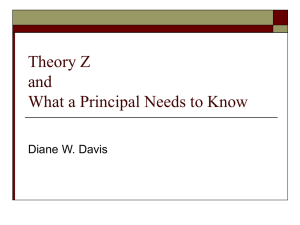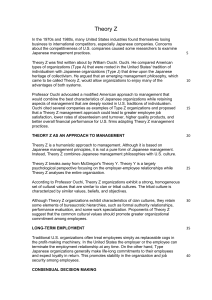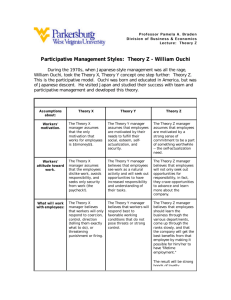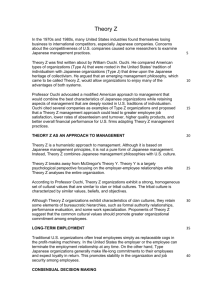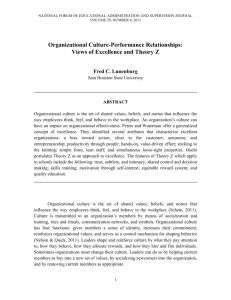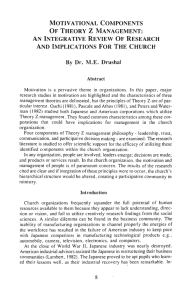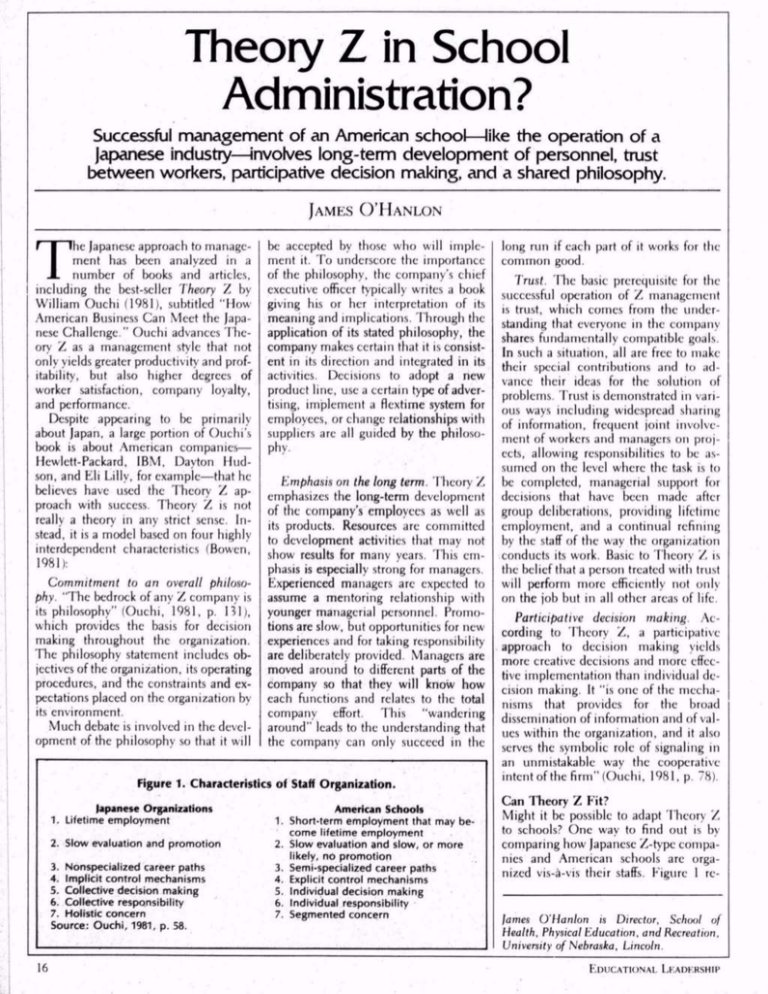
Theory Z in School
Administration?
Successful management of an American school—like the operation of a
Japanese industry—involves long-term development of personnel, trust
between workers, participative decision making, and a shared philosophy.
JAMES O'HANLON
T
he Japanese approach to manage
ment has been analyzed in a
number of books and articles,
including the best-seller Theory Z by
William Ouchi (1981), subtitled "How
American Business Can Meet the Japa
nese Challenge." Ouchi advances The
ory Z as a management style that not
only yields greater productivity and prof
itability, but also higher degrees of
worker satisfaction, company loyalty,
and performance.
Despite appearing to be primarily
about Japan, a large portion of Ouchi's
book is about American companies
Hewlett-Packard, IBM, Dayton Hud
son, and Eli Lilly, for example that he
believes have used the Theory Z ap
proach with success. Theory Z is not
really a theory in any strict sense. In
stead, it is a model based on four highly
interdependent characteristics (Bowen,
1981):
Commitment to an overall philoso
phy. "The bedrock of any Z company is
its philosophy" (Ouchi, 1981, p. 131),
which provides the basis for decision
making throughout the organization.
The philosophy statement includes ob
jectives of the organization, its operating
procedures, and the constraints and ex
pectations placed on the organization by
its environment.
Much debate is involved in the devel
opment of the philosophy so that it will
be accepted by those who will imple
ment it. To underscore the importance
of the philosophy, the company's chief
executive officer typically writes a book
giving his or her interpretation of its
meaning and implications. Through the
application of its stated philosophy, the
company makes certain that it is consist
ent in its direction and integrated in its
activities. Decisions to adopt a new
product line, use a certain type of adver
tising, implement a flextime system for
employees, or change relationships with
suppliers are all guided by the philoso
phy.
Emphasis on the long term. Theory Z
emphasizes the long-term development
of the company's employees as well as
its products. Resources arc committed
to development activities that may not
show results for many years. This em
phasis is especially strong for managers.
Experienced managers arc expected to
assume a mentoring relationship with
younger managerial personnel. Promo
tions are slow, but opportunities for new
experiences and for taking responsibility
are deliberately provided. Managers are
moved around to different parts of the
company so that they will know how
each functions and relates to the total
company effort. This "wandering
around" leads to the understanding that
the company can only succeed in the
Figure 1. Characteristics of Staff Organization.
lapanese Organizations
1. Lifetime employment
2. Slow evaluation and promotion
3. Nonspecialized career paths
4. Implicit control mechanisms
5. Collective decision making
6. Collective responsibility
7. Holistic concern
Source: Ouchi, 1981, p. 58.
16
American Schools
1. Short-term employment that may be
come lifetime employment
2. Slow evaluation and slow, or more
likely, no promotion
3. Semi-specialized career paths
4. Explicit control mechanisms
5. Individual decision making
6. Individual responsibility
7. Segmented concern
long run if each part of it works for the
common good.
Trust. The basic prerequisite for the
successful operation of Z management
is trust, which comes from the under
standing that everyone in the company
shares fundamentally compatible goals.
In such a situation, all are free to make
their special contributions and to ad
vance their ideas for the solution of
problems. Trust is demonstrated in vari
ous ways including widespread sharing
of information, frequent joint involve
ment of workers and managers on proj
ects, allowing responsibilities to be as
sumed on the level where the task is to
be completed, managerial support for
decisions that have been made after
group deliberations, providing lifetime
employment, and a continual refining
by the staff of the way the organization
conducts its work. Basic to Theory Z is
the belief that a person treated with trust
will perform more efficiently not only
on the job but in all other areas of life.
Participative decision making. Ac
cording to Theory Z, a participative
approach to decision making yields
more creative decisions and more effec
tive implementation than individual de
cision making. It "is one of the mecha
nisms that provides for the broad
dissemination of information and of val
ues within the organization, and it also
serves the symbolic role of signaling in
an unmistakable way the cooperative
intent of the firm" (Ouchi, 1981, p. 78).
Can Theory Z Fit?
Might it be possible to adapt Theory Z
to schools? One way to find out is by
comparing how Japanese Z-typc compa
nies and American schools arc orga
nized vis-a-vis their staffs. Figure I rc-
Jantes O'Hanlon is Director, School of
Health, Physical Education, and Recreation,
University of Nebraska, Lincoln.
EDUCATIONAL LKADKRSHIP
veals several significant differences in
their functions. Clearly, a number of
changes would be required for school
management to be conducted in a Z
manner.
Lifetime employment. The focus of
the evaluation and development of
teachers is very short-term. Teachers are
evaluated annually with minimal atten
tion to planning for growth over a period
of years. Inservice programs are based
on immediate needs and are generally
too brief and poorly financed for any
significant impact. Application of the
lifetime employment concept requires
establishing career paths and supporting
greatly increased amounts of inservice
education. A long-term development
plan should be maintained for each
teacher to ensure that he or she will
engage in a variety of growth producing
activities.
Lortic (1975), in his classic sociologi
cal study of teaching, pointed out that
the lack of involvement of the school in
the continuing development of the
teacher has contributed to the weakness
of teaching as an occupation. Further
more, he found that persons who enter
teaching do not view it as a lifetime
career and thus arc less willing to invest
in their own long-term development.
Dreeben (1970) concluded that neither
preservicc nor on-the-job training of
teachers requires the commitment or
produces the expertise that will bind
individuals to the profession. If Theory
Z management could lessen these prob
lems, it could certainly contribute to
more effective schools.
Slow evaluation and promotion. The
lack of promotion opportunities for the
classroom teacher as a teacher has long
been recognized as a serious motivation
al problem. Theory Z, with its emphasis
on giving special responsibilities to indi
viduals regardless of rank and on partici
pative decision making, might provide
an important alternative route. Oppor
tunities to work on meaningful tasks
with others in the school organization,
including top administrators, might also
strengthen collcgiality within the school
and create closer bonds between teach
ers and their work.
Nonspecialized career paths. Ouehi
cites research that "strongly suggests"
that workers who continually face new
tasks arc more vital, productive, and
satisfied with their work than those who
stay in one job (p. 32). The so-called
"wandering around" practiced by man
agers in Z companies could be realized
FEBRUARY 1983
in schools by changing teachers' assign
ments every few years so that they expe
rience the challenge of different grade
levels, courses, and even school set
tings. They also might take on some
administrative duties. In addition to
stimulating teachers, these varied expe
riences might encourage the needed
holistic concern.
Implicit control mechanisms. The key
to implicit control mechanisms is mutu
al understanding between teachers and
administrators. Common commitment
can arise only through sharing tasks and
joint efforts to support the growth of
students. Implementation of the Z idea
of "management by walking around"
direct participation by managers as op
posed to distant order giving would
require very different priorities for ad
ministrators. Perhaps being managed
through implicit control mechanisms
will produce teachers who view them
selves as capable professionals rather
than as mere employees.
Collective decision making and re
sponsibility. Drecbcn (1970) postulates
that "the distinguishing characteristic of
school systems is the vague connection
between policy formation at both the
high and middle levels of the hierarchy
and its implementation at the level
where instruction takes place the
classroom" (p. 48). Many top down and
even group decisions are carried out
only partially, while the teacher operat
ing in his or her own classroom makes
hundreds of decisions that may or may
not support those made by other teach
ers. Lortie's analysis of teacher satisfac
tion raises some doubt as to whether
teachers are willing to give up any of
their control over decisions in their
classrooms. Moving to a truly participa
tive approach would thus be a major
change for schools.
The job of educating young people,
however, certainly calls tor the coordi
nated efforts of many people. Ouchi
concludes that "Productivity is a prob
lem that can be worked out through
coordinated individual efforts in a pro
ductive manner and of giving employees
the incentives to do so by taking a
cooperative, long range view" (p. 5).
Furthermore, he explains that improved
coordination increases production by
capturing the emotional and mental
energy of workers in analyzing, plan
ning, and decision making.
Holistic concern. The schooling of
youth in the United States is very seg
mented. The seventh grade teacher
knows next to nothing about what the
sixth grade teacher is doing; the English
teacher is uninformed about what the
Figure 2. Steps to Implement Theory Z.
' -'•':
1. Administrative staff studies and debates Theory Z.
2. Administrative staff identifies the school's current, actual management (decisionmaking) system.
3. The chief administrator defines the characteristics of Theory Z to which he or she can
be committed.
4. Administrative staff works with teachers to develop a set of procedures for imple
menting the characteristics identified in step 3.
5. Administrative staff and teachers work together to develop the interpersonal skills
needed to implement Theory Z.
6. Administrative staff conducts a short-term test of the new management procedures
and gathers feedback on how they work.
7. Administrative staff involves the school board and teachers' association in their goals
relative to Theory Z.
8. The board establishes policies to create the environment necessary to stabilize
employment.
9. Administrative staff and teachers establish a system for slow evaluation and promo
tion.
10. Administrative staff establishes a system for long-term faculty development.
11. Administrative staff initiates implementation of Theory Z starting at top levels of
administration.
12. Administrative staff seeks areas to implement participation of faculty, students, and
community in decision making.
13. All permit the development of holistic relationships in which those concerned with
the school work together to improve it.
Adapted from Ouchi, 1981, pp. 99-127.
math teacher is doing, and so on. Ques
tions of how educational experiences fit
together and how they lead to students'
overall development do not receive
much attention. Moving away from the
traditional, highly segmented school
would be difficult. A Z company focuses
its concern on its long-term business
success. Such a focus of concern in the
schools is easy to identify the learner.
Implementing Theory Z
Ouchi has suggested a series of steps for
implementing Theory Z as a manage
ment scheme. These steps, reformulat
ed to fit the school situation, are pre
sented in Figure 2. While they are to be
carried out by administrators and faculty
members working together, the chief
administrator is the key to success. Im
plementation of Theory Z must begin at
the top and work its way down through
the organization. The entire implemen
tation process is slow, taking several
years to complete.
pommitment to Theory Z, while ab
solutely necessary, will not be enough
for successful implementation. Admin
istrators and teachers alike will need to
learn the skills of participative decision
making. These skills cannot be assumed
to exist; definitive activities for their
development must be undertaken. Fur
thermore, strategies for collecting feed
back on the attempts to change the
management style need to be identified
and established to guide the Theory Z
implementation. These strategies may
be similar to those used later to evaluate
the effectiveness of decisions made in
the participative process.
Should Theory Z Be Applied in
Schools?
Ouchi's conclusions about what makes
for effective management are not with
out their critics. Bruce-Briggs (1982) has
charged that Ouchi has totally misinter
preted the Japanese situation. To him,
the essential ingredient in Japanese eco
nomic success is the discipline of the
work force, which is a product of Japa
nese traditions. Bruce-Briggs states that
not only would it be silly, but also
dangerous to try to apply Japanese meth
ods out of the context of a "labor force
disciplined by a social hierarchy con
trolled by an oligarchy."
Many would probably agree with
Bruce-Briggs that Theory Z is simply a
"new brand name to peddle an old
ideological package," fit only for a Uto
pian situation. Some will undoubtedly
18
view the Z ideas as too "soft" and not
authority-oriented enough to be effec
tive. If these ideas really have been
effective for major corporations, howev
er, perhaps they do have some power to
produce results. A decision about
whether these concepts are useful for
management in education, moreover,
should depend on an analysis of the
school situation.
The Theory Z ideas may have poten
tial for addressing two long time prob
lems in American education. Lortie's
excellent analysis describes the weakness
of teaching as a subculture. Prominent
among the factors contributing to this
condition are the lack of a common
language among teachers, the failure of
teachers to establish adequate support
ing relationships with each other, and
the stagelessness of teaching as a career,
which depresses teacher motivation.
The emphasis in Z on the development
of the worker-teacher through broader
participation and work experiences and
on the exercising of collective responsi
bility for decision making and imple
mentation may have promise for dealing
with this weakness.
The second problem is that of the
segmented nature of the school. Indi
vidual teacher entrepreneurship may
provide the basis for much of what
teachers enjoy about their jobs, but it is
inconsistent with the development of
the student. Learning is a long-term,
multifaceted process. According to Lor
tie's study, teachers desire to "reach"
every student, develop a positive attitude
to learning on the part of their students,
and produce moral students. These ends
will not be accomplished through a
group of isolated efforts. Again Theory
Z may provide a basis for coordinating
the efforts of the school.
Would it be worth our while to study
the application of Theory Z manage
ment to schools? I'll think about that
some more as I drive home from work in
my Honda. CH
References
Bowen, W "Lessons from Behind the
Kimono." Fortune 103 (June 15, 1981):
247-250.
Bruce-Briggs, B "The Dangerous Folly
Called Theory Z." Fortune 1 05 (May 17,
1982)-. 41-53.
Dreeben, R. The Nature of Teaching.
Glenview. 111.. Scott, Foresman, 1970.
Lortie, C. Schoolteacher. Chicago: The
University of Chicago Press, 1975.
Ouchi, W. Theory Z . Reading, Mass.:
Addison-Wesley, 1981.
Successful in Japan anc
involve staff members in
I
f educators are to have some leverage
in increasing productivity and quali
ty in America's schools in the next
few years, we must focus our energies
on the most potent and expensive re
sources under our control the people
who work in our schools.
There are many methods school ad
ministrators can use to accomplish this
goal. One possible approach the qual
ity circle has been credited by observ
ers of Japanese industry as being a key
component in increasing employee pro
ductivity. In the United States, the con
cept has already moved from industrial
settings to banks, hospitals, govern
ment, and service organizations. By
spring 1983 over 4,000 organizations
will be implementing quality circles.
The quality circle is a participative
management tool designed to systemati
cally harness the brain power of employ
ees to solve an organization's problems
of productivity and quality. While there
are certainly many differences in the
ways industry and education operate,
they do share one attribute: the public
distrusts the quality of their products.
Whether it is American cars or Ameri
can high school graduates, both arc
perceived as not as good as they used to
be.
As yet, few school systems have used
the quality circle concept. However, a
growing number of school administra
tors are tentatively examining its tech-
Larry Chase is Executive Director, North
west Educational Cooperative, Arlington
Heights, Illinois.
EDUCATIONAL LEADKRSHIP
Copyright © 1983 by the Association for Supervision and Curriculum
Development. All rights reserved.

